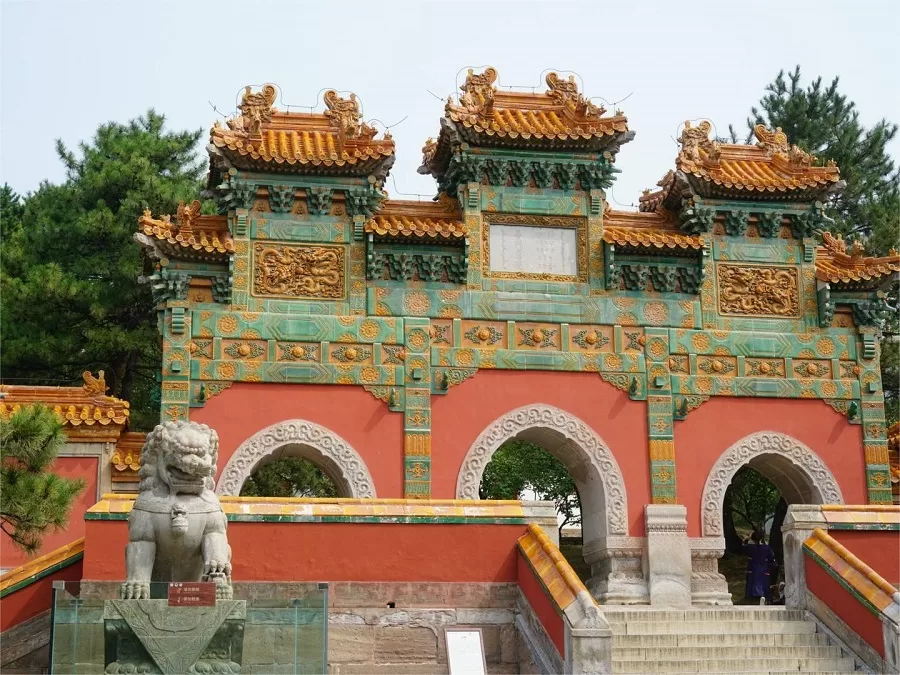Xumi Fushou Temple (须弥福寿之庙), situated on the northern side of Chengde’s Mountain Resort, was commissioned by Emperor Qianlong in 1780 as a Tibetan Buddhist monastery for the sixth Panchen Lama, who was visiting to offer congratulations. Recognizing the hot climate of Beijing compared to Tibet, Emperor Qianlong decided to construct Xumi Fushou Temple in Chengde, known as Rehe during that time, as a summer retreat for the sixth Panchen Lama.
Modeled after Tibet’s renowned Tashilhunpo Monastery, the temple exhibits a remarkable level of craftsmanship and adheres to Tibetan architectural traditions. Covering an expansive area of 37,920 square meters, the temple stretches approximately 350 meters in depth and around 120 meters in width, featuring predominantly Tibetan architectural styles but also incorporating elements of Chinese temple design in its layout.
The temple, facing south, boasts a symmetrical arrangement of its main structures along the central axis. Its historical significance is underscored by the fact that the sixth, tenth, and eleventh Panchen Lamas all resided here at different points in history. Due to its association with the Panchen Lamas, Xumi Fushou Temple is colloquially referred to as the Panchen Lama’s Summer Palace. The fusion of Tibetan and Han architectural elements, along with its historical importance, makes Xumi Fushou Temple a notable cultural and religious site within the Chengde Mountain Resort.
Table of Contents
- Basic Information
- Location and Transportation
- Highlights of Xumi Fushou Temple
- Video about Xumi Fushou Temple
- Useful Tips Summarized from Reviews
- Attractions near Xumi Fushou Temple
Basic Information
| Estimated Length of Tour | 1 – 2 hours |
| Combined Ticket for Putuo Zongcheng Temple and Xumi Fushou Temple | 60 RMB 30 RMB |
| Opening Hours | 8.00 – 18.00 (1st May – 9th October) 8.00 – 17.30 (1st April – 30th April) 8.00 – 17.00 (10th October – 31st March the next year) |
| History | Established in 1780 to welcome Panchan the 6th |
| Area | 37,920 square meters |
| Telephone Number | 0086-0314-2162972 |
Location and Transportation
Situated about 200 kilometers northeast of Beijing, Xumi Fushou Temple in Hebei Province is a captivating retreat within the UNESCO-listed Chengde Mountain Resort and its Outlying Temples. The temple’s strategic location amidst lush hills and verdant valleys creates a harmonious blend of natural beauty and architectural marvel.
To get there, tourists can take bus 12, 118, or tourist line 2 and get off at Xumi Fuzhou Temple Stop.
Highlights of Xumi Fushou Temple
Glazed Archway

The glazed archway in Xumi Fushou Temple follows a Han-style architectural design with three bays, four pillars, and seven levels. Characterized by uplifted eaves and overlapping bracket sets, the archway features a distinctive style. Crowned by a glazed plaque bearing Emperor Qianlong’s inscription “总持佛境” in four scripts (Manchu, Han, Mongolian, and Tibetan), meaning “Hold the Buddha’s Realm,” this archway serves as a symbolic transition point and a boundary marker, denoting a shift in the overall architectural style and hierarchy within the temple complex.
Dahongtai Terrace

Dahongtai Terrace stands as the central edifice of Xumi Fushou Temple. Its flat roof is adorned with four corner pavilions, each topped with glazed tiles. Animal sculptures, deer on the northern corners and peacocks on the southern corners, embellish the ridge. Surrounding the interior are three levels of wooden galleries with over 400 rooms. The first level features images of Four Heavenly Kings, Eighteen Arhats, and the founder of the Gelug school, Je Tsongkhapa. In the southeast corner of the second level, an octagonal three-story pagoda is adorned with auspicious dragon and phoenix carvings. The third level houses seven intricately carved golden altars, with a buddha at the center.
Buddhist Artistry

The Buddhist artistry of Xumi Fushou Temple unfolds as a captivating tapestry of devotion and creativity. Intricate Thangka paintings adorn the walls, depicting intricate spiritual narratives. These vivid expressions of Tibetan artistry offer insights into the depth of Buddhist culture and devotion. The temple’s main hall hosts statues of revered deities, their intricate details reflecting the skilled craftsmanship of the Qing Dynasty. Every brushstroke and sculpted form resonates with spiritual significance, inviting visitors to contemplate the intricate interplay between faith and artistic expression. Within the temple’s walls, Buddhist art becomes a gateway to understanding the profound connections between the human spirit and the divine.
Miaogao Zhangyan Hall

Miaogao Zhuangyan Hall, located at the central courtyard enclosed by the grand terrace of Dahongtai, stands three stories tall with a width of seven bays. This hall served as the venue for the sixth Panchen Lama’s discourses. Its three interconnected levels exhibit a striking architectural style with double-eaved, pointed roofs adorned with copper-gilded fish-scale tiles. The roof is further embellished with four sets of gilded copper dragons, each weighing around one ton. The first level houses a statue of the Gelug school founder, Tsongkhapa, with an image of Shakyamuni slightly to the north. The second level features sculptures of Shakyamuni, Ananda, and Kashyapa, along with eighteen Arhats. The third level contains a rotating pagoda where Emperor Qianlong prayed for longevity.
Video about Xumi Fushou Temple
Useful Tips Summarized from Reviews
Meaning of Xumi Fushou: Xumi Fushou translates to “as abundant and long-lived as Mount Sumeru,” symbolizing prosperity and longevity.
Imperial Connection: Xumi Fushou Temple in Chengde, along with Zongjing Dazhao Temple in Fragrant Hills, Beijing, were both palaces built by Emperor Qianlong for the Panchen Lama.
Free Shuttle Service: Conveniently, there is a free shuttle service between Xumi Fushou Temple and Putuo Zongcheng Temple, making transportation between the two scenic areas easy.





